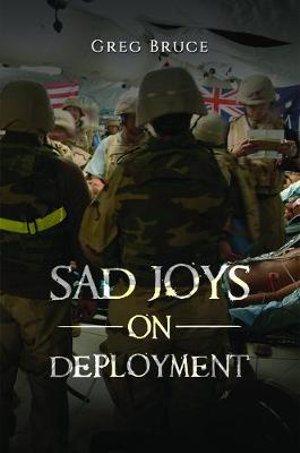Sad Joys on Deployment is the memoir of an orthopaedic surgeon1 in the Royal Australian Air Force Specialist Reserve (RAAFSR) who deployed overseas ten times on operations between 1995 and 2008.

RRP $20.50; Ursula Davidson Library call number 815 BRUC 2020
The author, Group Captain Gregor Bruce (Rtd), is a surgeon with extensive experience in the public and private sectors. He eventually became a civilian orthopaedic surgeon at RAAF Base, Richmond, New South Wales. There, he was persuaded to join the RAAFSR while continuing to serve as a civilian surgeon at the base and maintaining a private practice. In his RAAFSR capacity, he became a member of a three-person team of a general surgeon, an orthopaedic surgeon and an anaesthetist.
The Australian Defence Force (ADF) is heavily dependent on its reservists, no more so than in health services. It invites its reservist doctors to volunteer for deployments, usually of from one to four months’ duration, as the need arises. Greg Bruce accepted ten such invitations over 13 years and describes them briefly in Chapter 2: Kigali, Rwanda, 1995 (peacekeeping); Vanimo, Papua New Guinea, 1998 (humanitarian assistance); Bougainville, 1998 (peacekeeping); Dili, East Timor, 1999-2000, 2000 and 2001 (peacekeeping); Honiara, Solomon Islands, 2003 (peacekeeping); Balad, Iraq, 2004-05 (warfighting); Bali, Indonesia, 2005 (humanitarian assistance); and Tarin Kowt, Afghanistan, 2008 (warfighting).
In four, short, generic chapters, Bruce describes medical issues he encountered and the types of surgeries he per – formed when deployed. These chapters may be of more interest to the medically-minded than the general reader.
In a further series of 15 chapters of more general interest, most of which, again, are generic covering all deployments, Bruce describes how he was recruited into the RAAFSR, preparation for deployment, travel to the operational area, the military base and its security, the hospital workplace, military hardware and his choice of personal weapons, recreation on and off base, local citizens in the operational area, managing differences in culture between Australian and allied forces, encounters with hostile forces, working with the United Nations and non-government organisations, and issues and adjustments on returning home.
He concludes the book with reflections on his deployments, including some lessons learned; comments on the ADF from the perspective of a reservist; and an epilogue, which includes some observations on post-traumatic stress disorder and his reasons for writing the book. The book’s name, we learn, reflects both the professional fulfilment and personal pleasure he gained from each operational deployment, diminished by the sadness he experienced from the human misery he observed everywhere – hence “sad joys”.
The book also has an appendix containing nine, brief, well-written articles that he penned in Balad, Iraq, between 10 January and 20 February 2005 – they were published concurrently in the Daily Telegraph, Sydney. There also are 33 black-and-white photos of varying quality, some suggested further reading and a glossary.
I found the book very informative, particularly with respect to the provision of medical services on counterterrorism, peacekeeping and humanitarian operations in the period from 1995 to 2008. Also, Greg Bruce’s perspectives on the ADF and on working with allies are insightful. His listing of lessons to emerge is helpful, but his observation that the ADF does not seem to learn from errors made on previous deployments is concerning. Military historians, however, may quibble about his description of Sparrow Force and its fate in East Timor in 1942 (p. 98). It actually comprised 2/40th Australian Infantry Battalion, 2/2nd Independent Company and later 2/4th Independent Company, among others. While the infantry battalion surrendered on 23 February, the commando companies resisted until withdrawn by sea in January 1943. Only some commandos were captured and executed by the Japanese. Some historians also may query the relative significance of the Australian and American victories at Milne Bay and Guadalcanal (pp. 49 and 98-99), but I consider Bruce has assessed the relative significance accurately.
Unfortunately, the book lacks a coherent storyline, largely as a consequence of the generic approach taken in many chapters. This also has necessitated repetition – material presented in earlier chapters has had to be represented,
sometimes three or more times, to provide relevant context in later chapters. Further, the copy-editing leaves much to be desired in places, with some sections lacking fluency and others containing errors in syntax or spelling.
I would have preferred the book either to have addressed the deployments sequentially (the conventional
approach to a memoir of this type), or to have had the deployments grouped by type, e.g. humanitarian assistance (Vanimo, Bali), peacekeeping (Kigali, Bougainville, Dili, Honiara) and warfighting (Balad, Tarin Kowt). Either approach may have provided a better storyline and reduced repetition.
These drawbacks notwithstanding, Greg Bruce has keen eye for detail and enlivens his observations in places with colourful word pictures and a dry sense of humour. I commend the book to readers interested in the role of the ADF health services in the late 20th and early 21st centuries.
Reviewed for RUSINSW by David Leece – United Service, Vol. 71, No. 4, Summer 2020: 24
Contact MHHV Friend about this article.






